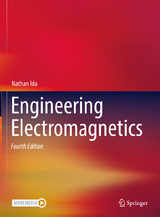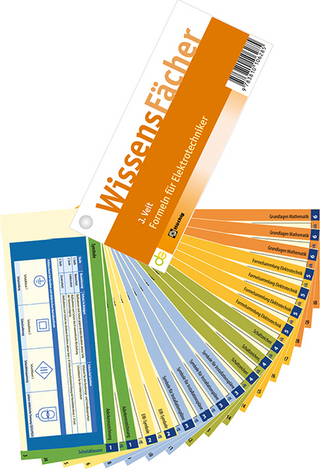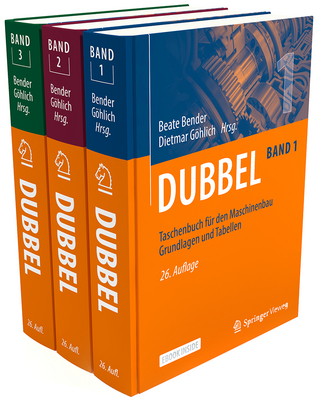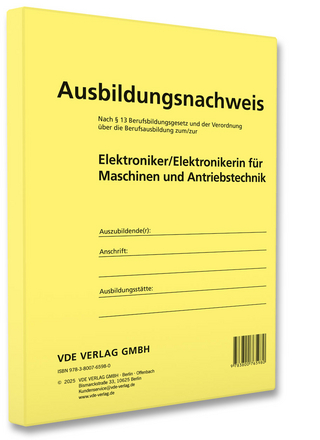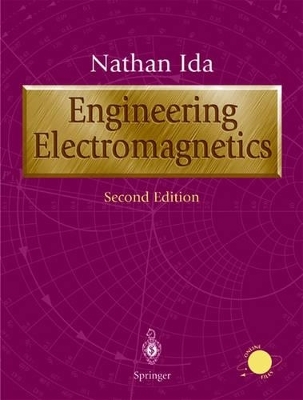
Engineering Electromagnetics
Springer-Verlag New York Inc.
978-0-387-20156-6 (ISBN)
- Titel erscheint in neuer Auflage
- Artikel merken
This text not only provides students with a good theoretical understanding of electromagnetic field equations but it also treats a large number of applications. No topic is presented unless it is directly applicable to engineering design or unless it is needed for the understanding of another topic. Included in this new edition are more than 400 examples and exercises, exercising every topic in the book. Also to be found are 600 end-of-chapter problems, many of them applications or simplified applications. A new chapter introducing numerical methods into the electromagnetic curriculum discusses the finite element, finite difference and moment methods.
Preface 1 Vector Algebra 1.1 Introduction 1.2 Scalars and Vectors 1.2.1 Magnitude and Direction of Vectors: The Unit Vector and Components of a Vector 1.2.2 Vector Addition and Subtraction 1.2.3 Vector Scaling 1.3 Products of Vectors 1.3.1 The Scalar Product 1.3.2 The Vector Product 1.3.3 Multiple Vector and Scalar Products 1.4 Definition of Fields 1.4.1 Scalar Fields 1.4.2 Vector Fields 1.5 Systems of Coordinates 1.5.1 The Cartesian Coordinate System 1.5.2 The Cylindrical Coordinate System 1.5.3 The Spherical Coordinate System 1.5.4 Transformation from Cylindrical to Spherical/penalty /@M / Coordinates 1.6 Position Vectors 2 Vector Calculus 2.1 Introduction 2.2 Integration of Scalar and Vector/penalty /@M / Functions 2.2.1 Line Integrals 2.2.2 Surface Integrals 2.2.3 Volume Integrals 2.3 Differentiation of Scalar and Vector/penalty /@M / Functions 2.3.1 The Gradient of a Scalar Function 2.3.1.1 Gradient in Cylindrical Coordinates 2.3.1.2 Gradient in Spherical Coordinates 2.3.2 The Divergence of a Vector Field 2.3.2.1 Divergence in Cartesian Coordinates 2.3.2.2 Divergence in Cylindrical and Spherical Coordinates 2.3.3 The Divergence Theorem 2.3.4 Circulation of a Vector and the Curl 2.3.4.1 Circulation of a Vector Field 2.3.5 Stokes'Theorem 2.4 Conservative and Nonconservative/penalty /@M / Fields 2.5 Null Vector Identities and Classification of Vector Fields 2.5.1 The Helmholtz Theorem 2.5.2 Second-Order Operators 2.5.3 Other Vector Identities 3 Coulomb's/penalty /@M / Law and the Electric Field 3.1 Introduction 3.2 Charge and Charge Density 3.3 Coulomb's Law 3.4 The Electric Field Intensity 3.4.1 Electric Fields of Point Charges 3.4.1.1 Superposition of Electric Fields 3.4.1.2 Electric Field Lines 3.4.2 Electric Fields of Charge Distributions 3.4.2.1 Line Charge Distributions 3.4.2.2 Surface Charge Distributions 3.4.2.3 Volume Charge Distributions 3.5 The Electric Flux Density: An/penalty /@M / Initial/penalty /@M / Definition 3.6 Applications 3.7 Experiments 4 Gauss's/penalty /@M / Law and the Electric/penalty /@M / Potential 4.1 Introduction 4.2 The Electrostatic Field: Postulates 4.3 Gauss's Law 4.3.1 Applications of Gauss's Law 4.3.1.1 Calculation of the Electric Field Intensity 4.3.1.2 Calculation of Equivalent Charges 4.4 The Electric Potential 4.4.1 Electric Potential due to Point Charges 4.4.2 Electric Potential due to Distributed Charges 4.4.3 Calculation of Electric Field Intensity from Potential 4.5 Materials in the Electric Field 4.5.1 Conductors 4.5.1.1 Electric Field at the Surface of a Conductor 4.5.2 Dielectric Materials 4.5.3 Polarization and the Polarization Vector 4.5.4 Electric Flux Density and Permittivity 4.5.4.1 Linearity, Homogeneity, and Isotropy 4.5.5 Dielectric Strength 4.6 Interface Conditions 4.6.1 Interface Conditions Between Two Dielectrics 4.6.2 Interface Conditions Between Dielectrics and/penalty /@M / Conductors 4.7 Capacitance 4.7.1 The Parallel Plate Capacitor 4.7.2 Capacitance of Infinite Structures 4.7.3 Connection of Capacitors 4.8 Energy in the Electrostatic Field: Point/penalty /@M / and/penalty /@M / Distributed Charges 4.8.1 Energy in the Electrostatic Field: Field Variables 4.8.2 Forces in the Electrostatic Field: An Energy Approach 4.9 Applications 4.1 Experiments 5 Boundary/penalty /@M / Value Problems: Analytic Methods of Solution 5.1 Introduction 5.2 Poisson's Equation for the Electrostatic Field 5.3 Laplace's Equation for the Electrostatic Field 5.4 Solution Methods 5.4.1 Uniqueness of Solution 5.4.2 Solution by Direct Integration 5.4.3 The Method of Images 5.4.3.1 Point and Line Charges 5.4.3.2 Charged Line over a Conducting Plane 5.4.3.3 Multiple Planes and Charges 5.4.3.4 Images in Curved Geometries 5.4.4 Separation of Variables: Solution to Laplace's/penalty /@M / Equation 5.4.4.1 Separation of Variables in Cartesian Coordinates 5.4.4.2 Separation of Variables in Cylindrical Coordinates 5.5 Experiments: The Method of Images 6 Boundary/penalty /@M / Value Problems: Numerical (Approximate) Methods 6.1 Introduction 6.1.1 A Note on Computer Programs 6.2 The General Idea of Numerical/penalty /@M / Solutions 6.3 The Finite Difference Method: Solution to the Laplace/hfill/ break and Poisson Equations 6.3.1 The Finite Difference Approximation: First-Order/penalty /@M / Derivative 6.3.2 The Finite Difference Approximation: Second-Order 6.3.3 Implementation 6.3.3.1 Implicit Solution 6.3.3.2 Explicit Solution 6.3.4 Solution to Poisson's Equation 6.4 The Method of Moments: An/penalty /@M / Intuitive/penalty /@M / Approach 6.5 The Finite-Element Method: Introduction 6.5.1 The Finite Element 6.5.1.1 The Triangular Element 6.5.2 Implementation of the Finite Element Method 7 The/penalty /@M / Steady Electric Current 7.1 Introduction 7.2 Conservation of Charge 7.3 Conductors, Dielectrics, and Lossy/penalty /@M / Dielectrics 7.3.1 Moving Charges in an Electric Field 7.3.2 Convection Current and Convection Current Density 7.3.3 Conduction Current and Conduction Current Density 7.4 Ohm's Law 7.5 Power Dissipation and Joule's Law 7.6 The Continuity Equation and Kirchhoff's Current Law 7.6.1 Kirchhoff's Current Law 7.7 Current Density as a Field 7.7.1 Sources of Steady Currents 7.7.2 Kirchhoff's Voltage Law 7.8 Interface Conditions for Current/penalty /@M / Density 7.9 Applications 7.1 Experiments 8 The Static Magnetic Field 8.1 Introduction 8.2 The Magnetic Field, Magnetic Field Intensity,/hfill/ break and Magnetic Flux Density 8.3 The Biot--Savart Law 8.3.1 Applications of the Biot--Savart Law to/penalty /@M / Distributed/penalty /@M / Currents 8.4 Ampere's Law 8.5 Magnetic Flux Density and Magnetic/penalty /@M / Flux 8.6 Postulates of the Static Magnetic Field 8.7 Potential Functions 8.7.1 The Magnetic Vector Potential 8.7.2 The Magnetic Scalar Potential 8.8 Applications 8.9 Experiments 9 Magnetic Materials 9.1 Introduction 9.2 Magnetic Properties of Materials 9.2.1 The Magnetic Dipole 9.2.2 Magnetization: A Model of Magnetic Properties of/penalty /@M / Materials 9.2.3 Behavior of Magnetic Materials 9.2.3.1 Diamagnetic and Paramagnetic Materials 9.2.3.2 Ferromagnetic Materials 9.2.3.3 Other Magnetic Materials 9.3 Magnetic Interface Conditions 9.3.1 Interface Conditions for the Tangential and Normal Components of the Magnetic Field Intensity H 9.4 Inductance and Inductors 9.5 Energy Stored in the Magnetic Field 9.5.1 Magnetostatic Energy in Terms of Fields 9.6 Magnetic Circuits 9.7 Forces in the Magnetic Field 9.7.1 Principle of Virtual Work: Energy in a Gap 9.8 Torque 9.9 Applications 9.1 Experiments 10 Faraday's/penalty /@M / Law and Induction 10.1 Introduction 10.2 Faraday's Law 10.3 Lenz's Law 10.4 Motional Electromotive Force: The/penalty /@M / dc/penalty /@M / Generator 10.5 Induced emf due to Transformer/penalty /@M / Action 10.6 Combined Motional and Transformer Action Electromotive Force 10.6.1 The Alternating Current Generator 10.7 The Transformer 10.7.1 The Ideal Transformer 10.7.2 The Real Transformer: Finite Permeability 10.7.3 The Real Transformer: Finite Permeability and/penalty /@M / Flux/penalty /@M / Leakage 10.8 Eddy Currents 10.9 Applications 10.1 Experiments 11 Maxwell's Equations 11.1 Introduction: The/penalty /@M / Electromagnetic/penalty /@M / Field 11.2 Maxwell's Equations 11.2.1 Maxwell's Equations in Differential Form 11.2.2 Maxwell's Equations in Integral Form 11.3 Time-Dependent Potential Functions 11.3.1 Scalar Potentials 11.3.2 The Magnetic Vector Potential 11.3.3 Other Potential Functions 11.4 Interface Conditions for the/penalty /@M / Electromagnetic/penalty /@M / Field 11.4.1 Interface Conditions for the Electric Field 11.4.2 Interface Conditions for the Magnetic Field 11.5 Particular Forms of Maxwell's/penalty /@M / Equations 11.5.1 Time-Harmonic Representation 11.5.2 Maxwell's Equations: The Time-Harmonic Form 11.5.3 Source-Free Equations 12 Electromagnetic Waves and Propagation 12.1 Introduction 12.2 The Wave 12.3 The Electromagnetic Wave Equation and Its Solution 12.3.1 The Time-Dependent Wave Equation 12.3.2 Time-Harmonic Wave Equations 12.3.3 Solution of the Wave Equation 12.3.4 Solution for Uniform Plane Waves 12.3.5 The One-Dimensional Wave Equation in Free Space and Perfect Dielectrics 12.4 The Electromagnetic Spectrum 12.5 The Poynting Theorem and Electromagnetic Power Density 12.6 The Complex Poynting Vector 12.7 Propagation of Waves in Materials 12.7.1 Propagation of Waves in Lossy Dielectrics 12.7.2 Plane Waves in Low Loss Dielectrics 12.7.3 Propagation of Plane Waves in Conductors 12.7.4 The Speed of Propagation of Waves and Dispersion 12.7.4.1 Group velocity 12.7.4.2 Velocity of Energy Transport 12.7.4.3 Dispersion 12.8 Polarization of Plane Waves 12.8.1 Linear Polarization 12.8.2 Elliptical and Circular Polarization 12.9 Applications 12.1 Experiments 13 Reflection and Transmission of Plane Waves 13.1 Introduction 13.2 Reflection and Transmission at a General Dielectric Interface: Normal/penalty /@M / Incidence 13.2.1 Reflection and Transmission at an Air-Lossy Dielectric Interface: Normal Incidence 13.2.2 Reflection and Transmission at an Air-Lossless Dielectric Interface: Normal Incidence 13.2.3 Reflection and Transmission at an Air-Conductor Interface: Normal Incidence 13.3 Reflection and Transmission at an/penalty /@M / Interface: Oblique Incidence on a/penalty /@M / Conductor 13.3.1 Oblique Incidence on a Conducting Interface: Perpendicular Polarization 13.3.2 Oblique Incidence on a Conducting Interface: Parallel Polarization 13.4 Oblique Incidence on Dielectric/penalty /@M / Interfaces 13.4.1 Oblique Incidence on a Dielectric Interface: Perpendicular Polarization 13.4.2 Oblique Incidence on a Dielectric Interface: Parallel/penalty /@M / Polarization 13.4.3 Brewster's Angle 13.4.3.1 Brewster's Angle for Parallel Polarization 13.4.3.2 Brewster's Angle for Perpendicular Polarization 13.4.4 Total Reflection 13.5 Reflection and Transmission for Layered Materials at Normal Incidence 13.5.1 Reflection and Transmission for a Lossy Dielectric Slab at Normal Incidence 13.5.2 Reflection and Transmission for a Lossless Dielectric Slab at Normal Incidence 13.5.3 Reflection and Transmission for a Conducting Slab at Normal Incidence 13.5.4 Reflection and Transmission for a Lossless Dielectric/penalty /@M / Slab Backed by a Perfect Conductor: Normal/penalty /@M / Incidence 13.6 Applications 13.7 Experiments 14 Theory of Transmission Lines 14.1 Introduction 14.2 The Transmission Line 14.3 Transmission Line Parameters 14.3.1 Calculation of Line Parameters 14.3.1.1 Resistance per Unit Length 14.3.1.2 Inductance per Unit Length 14.3.1.3 Capacitance per Unit Length 14.3.1.4 Conductance per Unit Length 14.4 The Transmission Line Equations 14.5 Types of Transmission lines 14.5.1 The Lossless Transmission Line 14.5.2 The Long Transmission Line 14.5.3 The Distortionless Transmission Line 14.5.4 The Low-Resistance Transmission Line 14.6 The Field Approach to Transmission/penalty /@M / Lines 14.7 Finite Transmission Lines 14.7.1 The Load Reflection Coefficient 14.7.2 Line Impedance and the Generalized Reflection Coefficient 14.7.3 The Lossless, Terminated Transmission Line 14.7.4 The Lossless, Matched Transmission Line 14.7.5 The Lossless, Shorted Transmission Line 14.7.6 The Lossless, Open Transmission Line 14.7.7 The Lossless, Resistively Loaded Transmission Line 14.8 Power Relations on a General Transmission Line 14.9 Resonant Transmission Line Circuits 14.1 Applications 14.11 Experiment 15 The/penalty /@M / Smith/penalty /@M / Chart, /hbox Impedance Matching, and 15.1 Introduction 15.2 The Smith Chart 15.3 The Smith Chart as an Admittance Chart 15.4 Impedance Matching and the Smith Chart 15.4.1 Impedance Matching 15.4.2 Stub Matching 15.4.2.1 Single Stub Matching 15.4.2.2 Double Stub Matching 15.5 Quarter-Wavelength Transformer Matching 15.6 Experiments 16 Transients on Transmission Lines 16.1 Introduction 16.2 Propagation of Narrow Pulses on Finite, Lossless Transmission Lines 16.3 Propagation of Narrow Pulses on Finite, Distortionless/hfill/ break Transmission Lines 16.4 Transients on Transmission Lines: Long Pulses 16.5 Transients on Transmission Lines: Finite-Length Pulses 16.6 Reflections from Discontinuities 16.7 Transients on Lines with Reactive Loading 16.7.1 Capacitive Loading 16.7.2 Inductive Loading 16.8 Initial Condition on Line 16.9 Experiments 17 Waveguides 17.1 Introduction 17.2 The Concept of a Waveguide 17.3 Transverse Electromagnetic, Transverse Electric,/hfill/ break and Transverse Magnetic Waves 17.3.1 Transverse Electromagnetic Waves 17.3.2 Transverse Electric (TE) Waves 17.3.3 Transverse Magnetic Waves 17.4 TE Propagation in Parallel Plate Waveguides 17.5 TM Propagation in Parallel Plate Waveguides 17.6 TEM Waves in Parallel Plate Waveguides 17.7 Rectangular Waveguides 17.7.1 TM Modes in Rectangular Waveguides 17.7.2 TE Modes in Rectangular Waveguides 17.7.3 Attenuation and Losses in Rectangular Waveguides 17.8 Other Waveguides 17.9 Cavity Resonators 17.9.1 TM Modes in Cavity Resonators 17.9.2 TE Modes in Cavity Resonators 17.1 Energy Relations in a Cavity Resonator 17.11 Quality Factor of a Cavity Resonator 17.12 Applications 18 Antennas and Electromagnetic Radiation 18.1 Introduction 18.2 Electromagnetic Radiation and Radiation Safety 18.3 Antennas 18.4 The Electric Dipole 18.4.1 The Near Field 18.4.2 The Far Field 18.5 Properties of Antennas 18.5.1 Radiated Power 18.5.2 Radiation Resistance 18.5.3 Antenna Radiation Patterns 18.5.3.1 Planar Antenna Radiation Pattern Plots 18.5.3.2 Rectangular Power Pattern Plots 18.5.3.3 Beamwidth 18.5.4 Radiation Intensity and Average Radiation Intensity 18.5.5 Antenna Directivity 18.5.6 Antenna Gain and Radiation Efficiency 18.6 The Magnetic Dipole 18.6.1 Near fields for the magnetic dipole 18.6.2 Far Fields for the Magnetic Dipole 18.6.3 Properties of the Magnetic Dipole 18.7 Practical Antennas 18.7.1 Linear Antennas of Arbitrary Length 18.7.1.1 The Half-Wavelength Dipole Antenna 18.7.1.2 Full- and Three-Halves-Wavelength Antennas 18.7.2 The Monopole Antenna 18.8 Antenna Arrays 18.8.1 The Two-Element Array 18.8.2 The $n$-Element Linear Array 18.9 Reciprocity and Receiving Antennas 18.1 Effective Aperture 18.11 The Radar 18.11.1 Types of Radar 18.12 Other Antennas 18.13 Applications Answers Index
| Erscheint lt. Verlag | 1.8.2007 |
|---|---|
| Zusatzinfo | biography |
| Verlagsort | New York, NY |
| Sprache | englisch |
| Maße | 178 x 235 mm |
| Gewicht | 1940 g |
| Themenwelt | Technik ► Elektrotechnik / Energietechnik |
| ISBN-10 | 0-387-20156-4 / 0387201564 |
| ISBN-13 | 978-0-387-20156-6 / 9780387201566 |
| Zustand | Neuware |
| Informationen gemäß Produktsicherheitsverordnung (GPSR) | |
| Haben Sie eine Frage zum Produkt? |
aus dem Bereich
